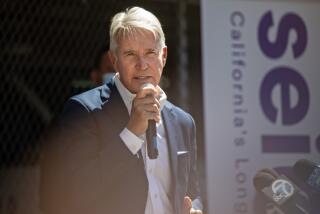Bruce Wayne Alcohol Level Above Limit, Report Shows
Bruce Wayne, the airborne radio traffic reporter known to millions of Southern California commuters, had an illegal level of alcohol in his blood when he died last year in the fiery crash of his single-engine plane, according to a report by the National Transportation Safety Board.
Wayne, 52, was killed instantly when his blue and white Cessna Cardinal slammed into an empty tractor-trailer rig moments after takeoff from Fullerton Municipal Airport at 6:18 a.m. on June 4, 1986.
The NTSB report said an autopsy has determined that Wayne had a blood-alcohol level of .04%--the level at which a pilot is considered legally intoxicated under Federal Aviation Administration regulations. The autopsy, performed by the Orange County Sheriff-Coroner’s Department, also showed that Wayne, who flew for radio stations KFI and KOST, suffered from a deteriorating liver, high blood pressure and heart problems from hypertension.
No Speculation on Cause
The report, prepared by a team of NTSB investigators, does not speculate on the cause of the crash or whether alcohol played a role. An NTSB spokesman in Washington said Friday that a separate report outlining the probable cause of the incident will be issued in about 30 days.
Wayne’s wife, Lois, has reportedly said that her husband had consumed two glasses of wine and gone to bed by 9 p.m. the night before the accident.
A supervising criminalist in the Orange County Crime Laboratory said Wayne’s body would have metabolized two 4-ounce glasses of table wine by midnight. “It is very remote that two or even three glasses of wine would still be in his system at 6 a.m.,” said Marty Breen, who oversees blood-alcohol testing for the county lab.
Breen said Wayne would have had to consume six or seven glasses of wine by 9 p.m. to have a .04% blood-alcohol level at the time of the crash.
Friends of Wayne said Friday that the veteran pilot rarely drank. Jhani Kaye, KFI-KOST station manager, said that at station parties she “rarely, if ever saw Bruce with a wine or beer. . . . He was too professional to mix drinking and flying.”
Rod Murphy, manager of the Fullerton airport where Wayne parked and maintained his plane, and a longtime associate, agreed: “It’s hard to believe that a man with that many flying hours, that level of experience, would go up in that condition. I’d be real surprised (if alcohol) was the cause of that crash.”
Wayne’s wife has said that her husband had been in good health. She attributed the crash to engine malfunction. A city employee working at the single-runway airfield that day told investigators that the plane’s engine appeared to backfire or sputter after takeoff.
But investigators were unable to find any engine problems that could have contributed to the accident, the report said. Lois Wayne could not be reached for comment Friday.
In California and other states, a motorist is considered legally intoxicated with a blood-alcohol level of .10%. An FAA spokesman in Washington said the limit is lower for pilots because altitude and thinner air “tends to exaggerate” the effects of alcohol.
Breen said a blood-alcohol level of .04% can impair judgment, vision and coordination. He said that a series of tests several years ago on a military flight simulator at El Toro Marine Air Corps Station showed that pilots with a blood-alcohol reading of .05% had trouble performing such “simple tasks” such as changing altitudes or properly reading instruments.
Wayne, who lived in Fullerton, died a month shy of completing 25 years as a flying traffic reporter, 18 of those in Southern California.
Wayne had logged more than 30,000 hours in the air and his voice was known to millions of Southland drivers, who knew him as the “Eye in the Sky.”
More to Read
Start your day right
Sign up for Essential California for news, features and recommendations from the L.A. Times and beyond in your inbox six days a week.
You may occasionally receive promotional content from the Los Angeles Times.






